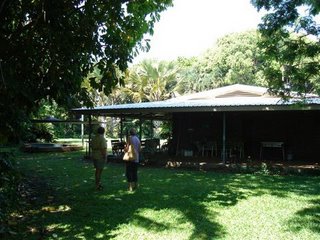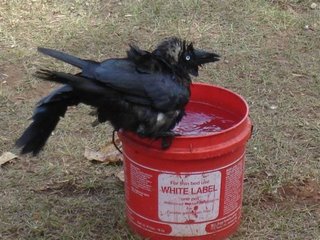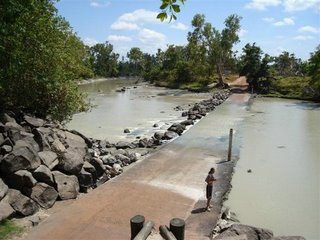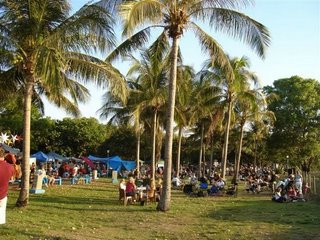Before getting on the road for the Northern Territory we were able to buy bottles of ice from the motel – these turned out to be far better than bags of ice which leaked and slopped all over the place as we motored along. State borders always give rise to concern over what we should not be carrying - to meet quarantine requirements. Paula had sent us an email confirming that when entering the Northern Territory no inspection was necessary. Sure enough we sailed through the border, George fortunately noticed a sign advising that we had to advance our watches by one and a half hours. Thank goodness we did not have to suffer the confusion that arose while crossing the Nullarbor. Time changing is a pain and throws out that first day. We weren’t ready for lunch when the clock dictated!
As we hummed along the Victoria Highway, would you believe that as we dipped down one of the many creeks, we saw suspended on the barbed wire fence spanning the creek-bed… three dead bats! Once again we began chewing over the reasons. Later, as we approached the northernmost tip of the Gregory National Park, the Gregory Tree heritage sign caught our interest and we turned off the highway to see what it was. A few kilometres down a dirt road brought us to a car-park in the middle of nowhere. For a few moments we were distracted by a shindig going on in trees close by us. Birds upset by a snake? Before spotting a path leading further into the bush. Being able to wander off into bush in this manner without a soul around or any sense of anxiety is one of the real privileges of exploring Australia! We have to doff our hats when we come across a beautifully made boardwalk surrounding a boab with views of the mighty Victoria River (the largest of the Territory rivers). Even more unexpected, was to be able to press buttons and hear tape recordings on different aspects of history at this spot. Not only a miracle of technology, but also the fact the equipment hadn’t been vandalised!
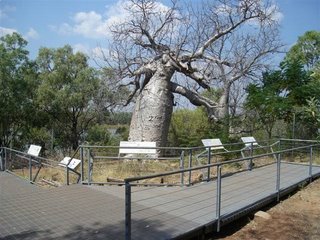
Information display around The Gregory Tree
Augustus Gregory turned out to be the first, born and bred Australian explorer. Creating his North Australia Expedition base camp here he had carved the arrival and departure date (1856) on the tree. Amazing that that in the intervening years the writing had not been distorted by growth and that graffiti dates as far back as that!
Not much further down the Victoria Highway was Big Horse Creek campground in the National Park where we were happy to stop for the night and spend the afternoon writing a birthday email to our son. Out here we find ourselves wondering how Keith may be celebrating this day; where Colleen and he may be on their canoe voyage down the Lugenda River in northern Mocambique; what adventures may have arisen during their month long river survey; and when they will get back to their base camp.
The Gregory National Park comprises two widely separated components. We saw very little of the larger western section because it appears to be devoted to a series of rugged and remote 4WD tracks. Although the smaller eastern section of the Park is separated from the western sector by almost 100km the intervening area, provided a semi-continuous view of the cliff-like scarp faces of Stokes Range, and was a joy to drive through. Fascinated by the proximity and appearance of the escarpment we were able to investigate Joe’s Creek in the eastern sector of the park by taking the looped 1.7km Nawulbinbin walk. This trail led up through the rocky scree slopes to the base of the escarpment where, capitalising on the availability of water that seeps from the cliffs above, a remarkable transition from open woodland to dense palm forest and ferns occurs. Examples of Aboriginal rock art on the walls of the cliffs, fabulous views of the valley below and the surrounding escarpments all added to another memorable experience.

A view on the Nawulbinbin walk - Gregory National Park
Stopping for lunch at Sullivan’s campground we decided it was too hot to hang around there for another night. Instead, we’d find a bush camp closer to Katherine. The Limestone Creek rest area looked good and we chose the quietest and shadiest spot furthest from the road. How often do we find that once parked, our presence seems to trigger others into stopping! In next to no time there were eight rigs and two tents encircling the centre picnic area. Towards evening, with the sound of birds returning to their roosts, the low orange glow of the sun high-lighting the eucalypt woodland we looked round at the other campers, to see most sitting outside their vans enjoying “five-sies”, the term used for sundowners here; the four young girls from the tents cooking up their “tea” at the communal fireplace before nightfall; a toddler enjoying a mighty long soak in a plastic storage box while her Dad prepared their portable gas barbeque - we had to laugh when she called for her potty! At dark it all culminated in the inimitable kookaburra’s symphony of cackles. So Australian and we love it!
The Riverview Caravan Park backed onto the Katherine River with hot springs close by. We first learnt of this river on Australia day in 1998 when it hit the news after rising so high that it nearly wiped out the town of Katherine. Already two days behind schedule with our blog we made haste for the internet café. No end of difficulties trying to send photos had us there for over an hour before we were able to leave. Off we went to soak away our frustrations in the hot springs. These springs are a series of thermal pools said to have a constant temperature of 32°C. For a hot day it did seem a bit ridiculous to go. However, we found it was in a beautifully shady glen and the water comfortably cool. It turned out to be a good gathering place for grey nomads coming and going, so good that we found ourselves chatting until our skins had turned into wrinkly white prunes. An old German escaping Melbourne winter annually for Wyndham was delighted to hear we’d been there. From him we learnt that the artist of the copper sculptures we’d been to see was no less than Reginald Birch, an Aboriginal who had written a book Wyndham Yella Fella. A book for us to look out for!
During our supper that evening we heard the sounds of balladeers Mac Manton and his wife entertaining from their seasonal corner close to our site. In next to no time we were drawn over to the little group enjoying his country and western ballads. Soon a frog was attracted too and when Lea pointed it out to George he was quick to recognise it as the “dreaded” cane toad. No sooner said that a squeal from somebody at the front as it hopped past her foot … “Oh! What an ugly toad”! To which our balladeer was quick to retort how can you guys be so rude about my Queensland export? Cane toads were introduced to Queensland in 1935 to control stalk borer beetles in the sugar cane fields. They spread throughout much of Queensland and northern New South Wales. By the time we arrived in Kakadu in the year 2000 there were major fears being expressed about the welfare of native species in the Park due to the toad’s inherent toxicity. The publicity and fears expressed had everyone looking out for the hitch-hiking toads under vehicles and devising ways and means to control the onslaught. No matter, the toads moved in regardless.
Arriving back in Western Australia (WA) in 2006 we are again bombarded by the WA cane toad initiative – trying to ensure that cane toads accidentally brought into WA do not become established. While we were in Kununurra we heard of the Toad-Busters who are trying to hold back the cane toad’s westward march at the Victoria River until a biological control solution can be applied. George, always the environmental realist, is of the opinion that given the ideal conditions that prevail across the Top End of Australia, nothing will prevent them from spreading into the Kimberley. Lea, always keen to do her bit, looks for stowaways!
The world’s largest classroom naturally lured Lea to the Katherine School of the Air (KSA) which offers distance education from pre-school to year 7 to students who live on cattle stations and remote Aboriginal communities as well as families travelling throughout Australia and overseas. These students are taught via radio and distance educational material which is mailed out to them. More recently, Interactive Distance Learning, using computers has been set up by KSA. Looking through a glass-fronted studio we were able to watch a teacher conduct a science lesson assisted by a young distance student in town for a couple of days. It made for an interesting morning for us both.

Katherine School of the Air
After all our problems with the internet yesterday our photos needed to be resent. The thought of subjecting ourselves to another hour of frustration was solved when we spotted a hand scrawled bill-board at the traffic lights. We decided to check if there was another internet facility and found the Didj Internet café. This organised place had our pictures go off successfully. As we paid, an amazing success story unfolded and we were there for the next hour ….. From a mixed heritage of Aboriginal, Chinese, Malaysian and White background, Glenn Bambu, enthralled us with his life story and bubbly personality. With all the odds stacked against him as a youngster - we left with a deep respect for all he has achieved and the goals he has set himself.
Easter Sunday 2000, we happened to stop in at Edith Falls and found this pretty spot so jam packed with people that we didn’t stay long! Years down the line it seemed a good place to revisit after leaving Katherine. A quick look around the beautifully laid out camp ground (not many inmates by midmorning!) along with some walking trails and a large water hole below the falls we could swim in made it an easy choice to stay. Once the heat of the day subsided we took the 2,6 km looped trail that led upstream. No easy walk along a garden path! We just love the way the trails are carefully planned to wind us in and out, up and down a variety of habitats that when you come out the other end you feel as if you have been on a mini adventure that has used all your muscles and given your heart a good little pump! At viewpoints Park Rangers provide seats. So too, in any really difficult terrain or problem area they put in steps or walkways which enhance rather than detract from your walk. We experienced just that on this particular trail. At the halfway mark we came over the rise to survey a wondrous sight of a water fall spilling into a rock basin with islands and rocky outcrops. Just like a story book picture with its array of deep and shallow places, stepping stones and channels to quiet sandy beaches before disappearing in little rapid formations out the other side. George couldn’t resist cooling off with a swim and before too long Lea was persuaded to take the plunge with her usual exuberant yell on entering cold water. Such fun and so invigorating! Like us the first time – we wonder just how many visitors come to see Edith Falls and leave without realising that there is far more to it than first appearances. That night the Park Ranger gave the last of the season’s slide show on the lawn overlooking Edith Falls. Sitting there, under the trees and the starry skies with the occasional wail from stone curlews (thick knees) added enormously to the presentation. The traditional owners call Edith Falls – Leliyn - meaning frilled necked lizard as the cliff face of the falls resemble this creature. Once a common inhabitant of the Park UNTIL…. the arrival of the cane toad! This Ranger also felt that knocking toads on the head was an exercise in futility!

Top Pool, Nitmiluk National Park
Our plans for a night at Copperfield Dam (outside Pine Creek) did not pan out. The state of last night’s moon influenced us in our decision to return to an old favourite of ours, the Hot Springs on the Douglas River. This nature park is owned by the Wagiman people. It is an important place for Woman’s Business Ceremonies and the park may be closed if a ceremony is in progress.
These thermal springs can reach 60°C. – Not an enticing prospect by day! We have learnt that the optimal time for a swim is at night. After dinner we made our way through the widely spread campground enjoying the sight of flickering camp fires and smell of wood-smoke down to the river. Every visit we make here is different – the saying- “you can never step into the same river twice” applies. There is nothing artificial about it. Easing ourselves into the shallow sandy stream of hot water we lay on our backs looking out on a world transformed by the light of the silvery moon. Tall paper-barks trees and screw palms lined the banks, flood debris of upturned trees and roots created strange sculptures. Attached to the margins of the channels, green ropes of filamentous algae gave Lea the creeps as pieces writhed in the current like serpents. Periodically, streams of effervescent bubbles emerged from the sand tickling our backs. We were overwhelmed by a sense of relaxation, peace and wonderment.
As we end this week we find ourselves over-nighting on the edge of an old World War II airstrip in the outer Darwin area. Over 10,000 Allied troops used the sixty airfields built between Darwin and Daly Waters in the 1940’s for the defence of the coastline. Here we are at Hughes Airfield and in the silence we reflect on its history and the tales this runway could tell.
Are we on our own? No! Another rig is further down the strip.
